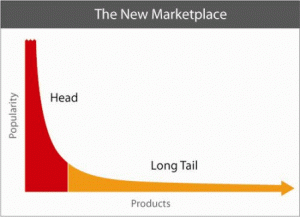As editor-in-chief of Wired Magazine Chris Anderson explains, the Long Tail illustrates the current movement from small purchases of mainstream products to larger purchases of uncommon ones. The vertical axis represents sales, which the horizontal axis represents number of products. The red shading in the curve demonstrates the area in which popular products have dominated markets. The orange shading in the curve shows the less popular products within niche markets. Anderson argues that it is within this part of the curve (hence The Long Tail), where our market is heading.
How has this changed The Long Tail? Anderson argues that retailers are now able to save more money by expanding their stock and providing ability to purchase them online. Usually, retailers stock well-sought after products that cater to the mainstream markets and dismiss the niche products to save money. However, Anderson notes that the strength that the Web provides for retailers today is the ability for stores to stock any product or service on their website, which expands the magnitude of choice for consumers. A variety of interests will be satisfied at a more microscopic level, which will hopefully reach more consumers than before.
Technology Blog’s Is Bricks and Clicks the Winning Online Strategy? illustrates research from Hitwise that shows retailers with a bricks and clicks marketing strategy have more market share over the “pure play” online-only retailers. This is what we also discussed previously with regards to consumers utilizing more than one channel to purchase products. Twenty-two percent of consumers who visit a website go on to purchase the product at a physical store. As David Nowell of Nowell Enterprises asserts, 91% of consumers research products online before making an in-store purchase, and the overall shopping experience in a bricks and mortar place is even greater than the 80% satisfaction that consumers experiences online!
So how does this relate to a bricks and clicks strategy? Stores are saving both time and money with their consumers and expanding their borders to cater to those niche markets that have been neglected for so long!

